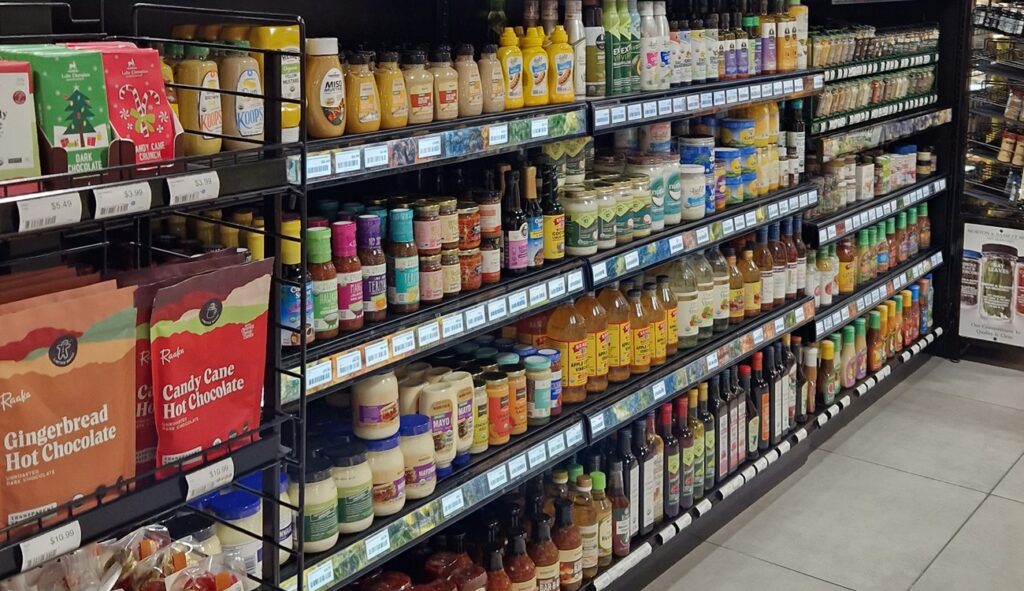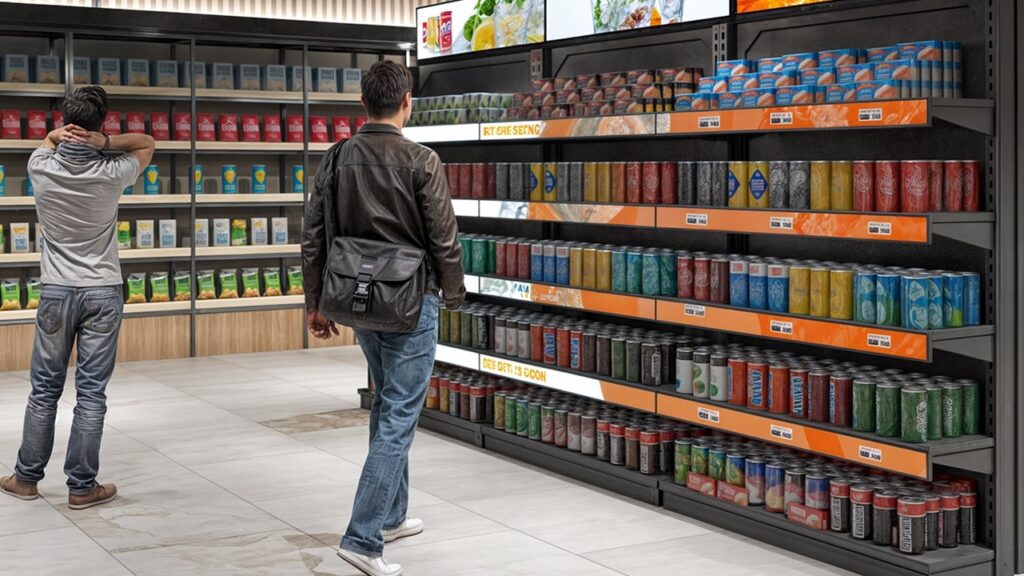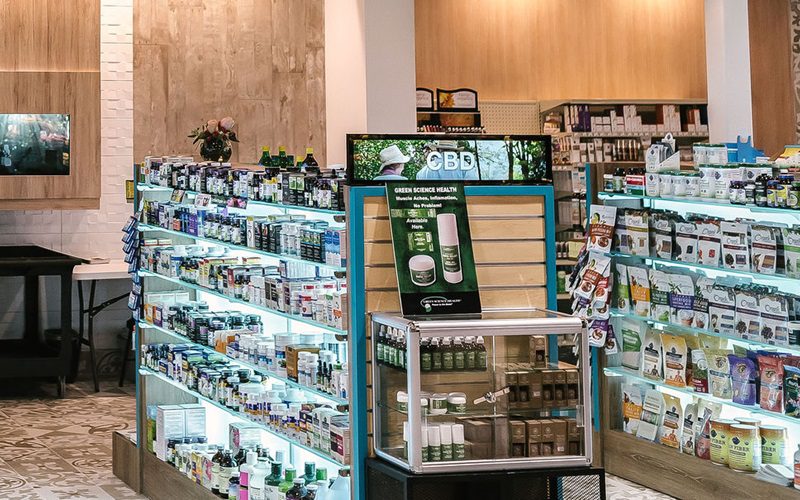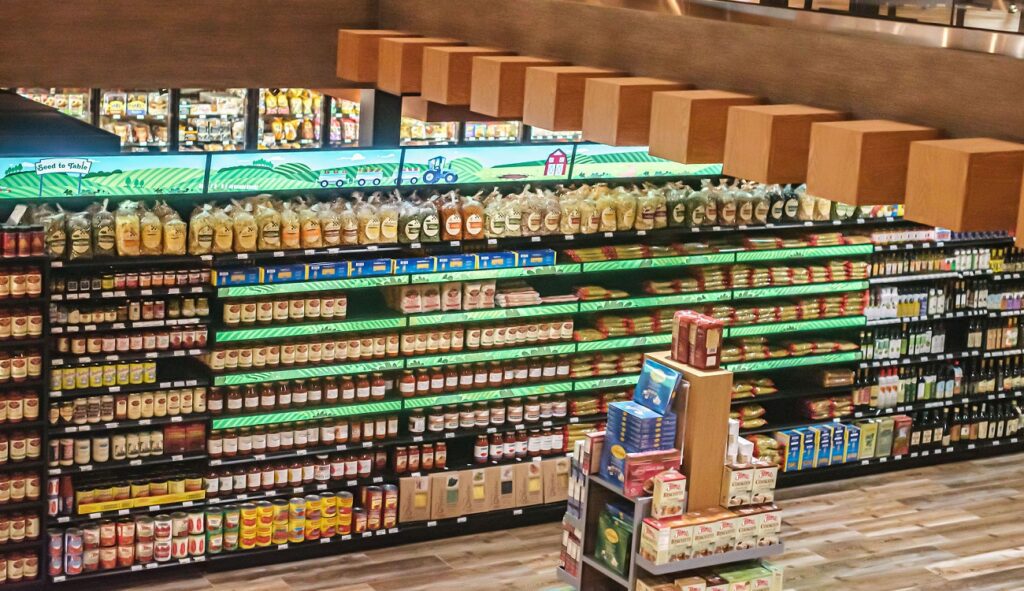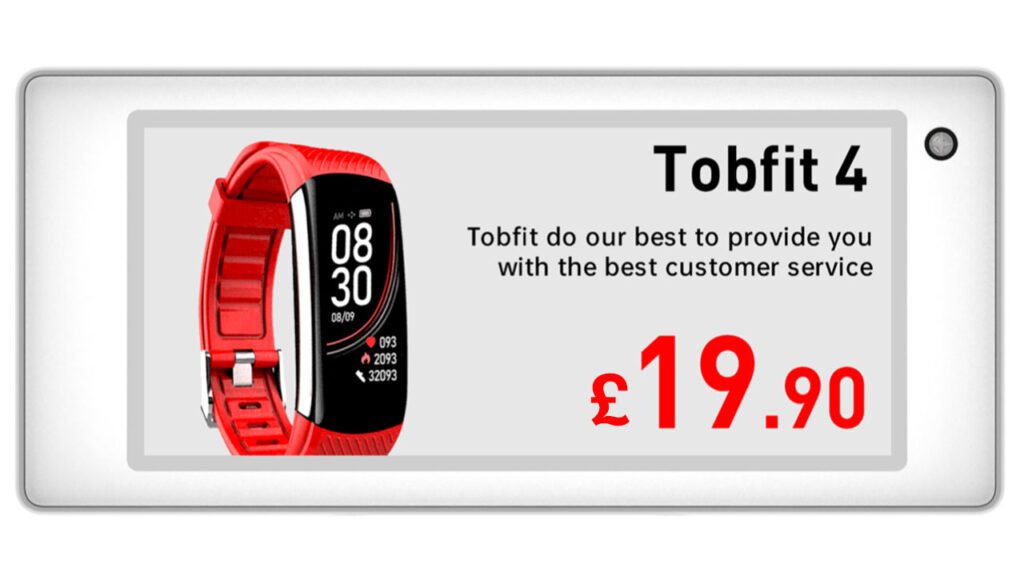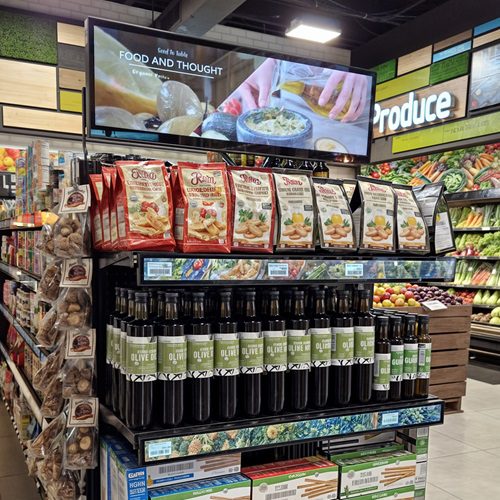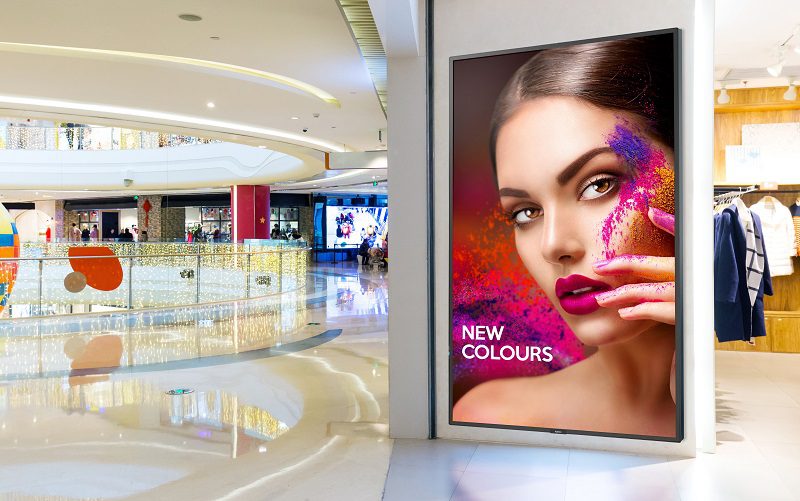The Retailer’s Guide To Buying and Using Digital Shelf Edge Labels
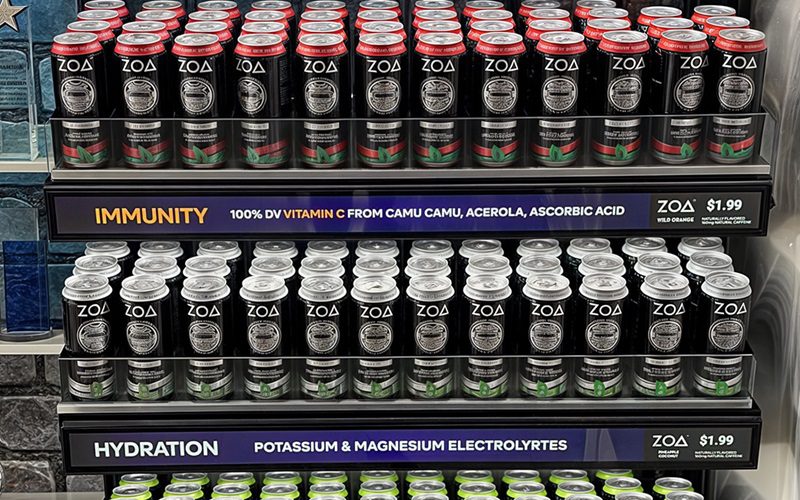
Digital shelf edge labels (also called ‘electronic shelf edge labels’ and ‘digital shelf labels’) are becoming more popular so, as specialists in retail digital signage, we thought we’d create a comprehensive guide to buying and using them specifically for retailers.
Digital shelf edge labels (DSELs) have been in widespread use across Europe in stores like Carrefour and in the USA in stores like Walmart, and are now increasingly being adopted in the UK.
Why? They’ve been shown to increase sales and operational efficiency, and to enhance the overall customer experience. As such DSELs are now starting to be embraced by forward-thinking retailers in the UK.
In this guide, we’ll cover:
- What Are Digital Shelf Edge Labels?
- Types of Digital Shelf Edge Labels
- Benefits of Digital Shelf Edge Labels
- Implementing Digital Shelf Edge Labels
- Best Practices for Digital Shelf Edge Labels
- Conclusion
What Are Digital Shelf Edge Labels?
Digital shelf edge labels replace traditional paper labels with electronic displays that show real-time pricing, promotions, and product information directly on the shelf. These labels can be screen-based or e-ink-based, providing a dynamic and interactive method for displaying information. By linking with a retailer’s central pricing system, DSELs can update automatically, ensuring price accuracy and compliance.
They are designed to be robust and to use minimal energy. They can be synchronised vertically or horizontally across different DSELs to make them even more eye-catching and draw attention to specific products, brands or promotions.
Types of Digital Shelf Edge Labels
E-Ink Displays
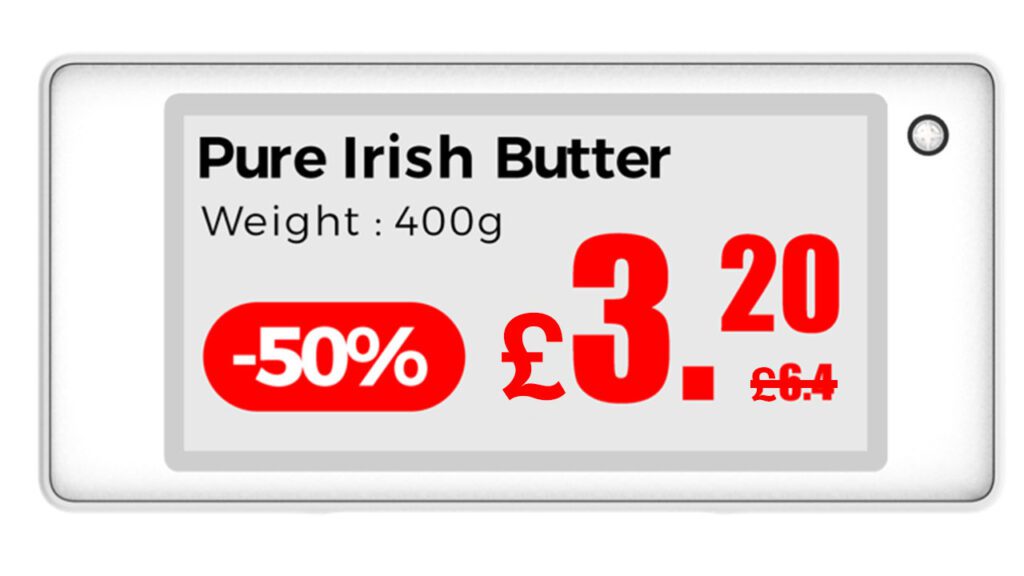 E-ink displays, similar to those used in e-readers like the Kindle. These displays use small capsules filled with clear fluid containing tiny particles that are positively and negatively charged. These capsules are situated in a thin film. When an electric current passes through the particles, the different-coloured particles move, changing what you can see on the display.
E-ink displays, similar to those used in e-readers like the Kindle. These displays use small capsules filled with clear fluid containing tiny particles that are positively and negatively charged. These capsules are situated in a thin film. When an electric current passes through the particles, the different-coloured particles move, changing what you can see on the display.
Screen-Based Displays
Screen-based displays, which can be either LCD or LED, have hardened protective casing. They work in the same way as standard TVs so they offer more vibrant, full-colour graphics and video capabilities. This makes them ideal for displaying animated promotional content and interactive elements. While they consume more power than e-ink displays, they are much more vivid, making it easy to attract customer attention and direct it towards specific products/brands/promotions.
Benefits of Digital Shelf Edge Labels
Real-Time Price Updates
One of the primary advantages of DSELs is the ability to update pricing in real-time. This functionality eliminates the need for staff to manually change paper labels, saving significant labour hours and reducing the risk of human error. Real-time updates also ensure that promotional prices are applied immediately across all stores, maintaining consistency and compliance with current regulations.
More Promotional Opportunities in the Same Space
DSELs are dynamic so they can provide a far greater volume of promotional opportunities, using the same amount of physical space. Retailers can use animation, videos, and interactive elements (e.g. QR codes) alongside pricing info to grab customers’ attention and promote products more effectively. For example, having an animated countdown showing when a specific promotion will end.
Although e-ink displays are less dynamic they, like screen-based displays, can change the visibility of promotions by time/day, such as lunchtime offers at midday and switching to more dinnertime-focussed promotions later in the day.
Improved Customer Experience
DSELs are more vivid and slicker-looking than paper pricing labels so they completely change the overall look and feel of a retail space.
They also allow customers to access much more product information which makes it easier for them to buy the right products. Information can be displayed using the display itself and with QR codes. This can give them better access to nutritional information, sustainability details, and serving suggestions/usage instructions. From the retailer’s point of view, customers’ ability to engage with content can increase dwell time which boosts the likelihood of purchases.
Accurate and Compliant Pricing
By integrating DSELs with centralised pricing systems, it ensures that all product information and prices displayed are accurate and compliant with legal requirements. This integration helps prevent discrepancies between displayed prices and those at the checkout, thereby maintaining customer trust and avoiding potential legal issues.
Environmental Benefits
The frequent disposal of paper labels contributes significantly to environmental waste. DSELs, on the other hand, can be updated electronically without generating physical waste. This shift not only reduces the environmental footprint of retailers but also aligns with broader sustainability goals.
The additional promotional space they create can also be used by retailers to educate customers about the sustainability efforts made by the company.
Implementing Digital Shelf Edge Labels
Build a Business Case
Digital shelf edge labels can save retailers time, reduce environmental impact, and create a more dynamic shopping experience that drives customer engagement and sales.
However, there’s no doubt that they are more expensive than printed paper labels. The cost of hardware and software purchase, initial set-up, content creation and management plus staff training can be significant.
That being the case, retailers should work with their digital signage provider to build a business case and assess whether it will stack up before doing anything else.
Selecting the Right Technology
Choosing between e-ink and screen-based displays depends on your specific needs. For static product pricing information and energy efficiency, e-ink displays are the most suitable. For dynamic, eye-catching content, screen-based displays are preferable. Retailers should also consider factors like screen size, resolution, and connectivity options when selecting DSELs.
Because digital shelf edge labelling is a relatively new technology, not all digital signage software can be used with it. Special content management software is needed and not all companies’ pricing and inventory systems will be easy to integrate with it so that price updates and product information are automatically updated and/or synchronised across all stores. Retailers should work with a digital signage provider to select the right hardware and to develop software to ensure seamless integration. This will also ensure minimal disruption during the transition.
Pilot
If you can forge a strong business case, we recommend implementing an initial pilot with guidance from a digital signage consultancy. This will allow you to test your assumptions on a small scale, which will be less expensive. It will ensure that your existing technologies will integrate well without causing issue, and that any new hardware that’s purchased is robust and vivid enough to deliver your desired results.
It can also give you success metrics that will help bolster your business case, or highlight any potential issues before you get too far down the line.
Stakeholder Engagement and Training
The sooner that retailers engage with stakeholders regarding the introduction of digital shelf edge labelling, the more likely it is that the project will succeed. This will help to create a consensus on the objectives, success metrics and who is to be involved at what stage. Projects often fail half-way through because some stakeholders are involved at too late at stage.
Proper training for staff is also essential to maximise the benefits of DSELs. Retailers should provide comprehensive training to the relevant staff on how to use the digital signage content management software, troubleshoot common issues, and support the ongoing creation of engaging content. Ongoing support from the digital signage provider is also crucial to address any technical challenges and ensure smooth operation.
Best Practices for Digital Shelf Edge Labels
Strategic Usage & Placement
There’s no point investing in DSELs and using them in the wrong place and on the wrong products. They have been shown to be most effective for higher-margin products, and new innovations to draw attention to them and explain the benefits of using them.
Many of the retailers using DSELs use them in strategic locations rather than across the board, as this allows them to draw attention to certain display areas.
On higher, eye-level shelf edges a series of DSELs can be used and synchronised together to create optimum visibility for a product or promotion.
Alternatively, they are often used at end caps. These are already a prime location for product display and the addition of DSELs will further highlight promotions and new products positioned on them. Complementary products positioned on end caps with animated video shown on DSELs making serving/styling suggestions can also enhance cross-selling opportunities.
Monitoring Performance
Like any other marketing channel, the key to success with digital shelf edge labels is to monitor results and look for incremental improvements.
Retailers should regularly track the performance using sales data and customer engagement metrics to assess what is working best.
Because DSELs are dynamic, it is possible to A/B test the effectiveness of content in different locations and identify the highest performing which can then be used across the board. It is also possible to test whether using DSELs in different ways – e.g. DSEL synchronization – can create an additional uplift in sales.
Implementing a feedback loop where data-driven insights lead to iterative improvements is key to maximising your return on investment.
Creating Engaging Content
High-quality content is essential for capturing customer attention and driving sales. Retailers that are investing in screen-based shelf edge displays should have a secondary budget for the creation of videos and animations to highlight product features and promotions.
Ideally, retail businesses should work with content creators that specialise in generating materials for digital signage. This will ensure that animation is timed/sized appropriately for the environment it’s being used in and doesn’t overwhelm customers with two much information.
Providing Value-Added Information
There’s little point in investing in DSELs and just showing basic pricing. Retailers should use them to either highlight promotions likely to interest customers or give them more/better information about the products on display.
This can include reviews, product quality information, styling tips/serving suggestions and sustainability or nutritional information. Providing this sort of additional information educates the customer helping to build trust and brand loyalty.
Conclusion
There is long list of benefits of using digital shelf edge labels. So, in our professional opinion are they appropriate for every retailer? No.
There are a wide range of different factors that will influence how long it will take a retailer to get a return on investment from DSELs. For some, the business case just won’t stack up. For others, it’s a no-brainer. And for many, a little can go a long way when it comes to the use of DSELs.
However, customers’ expectations are changing all the time. No-one can ignore the impact that online shopping has had on bricks and mortar stores. Customers expect more information at the point of sale, for example customer reviews, so stores are increasingly becoming a hybrid experience. The more demanding customers become and the more digital our in-store shopping experience becomes, the more outmoded shops with printed, paper-based displays will soon become.
Saturn has produced a white paper called ‘Re-energising retail – How the 2024 in-store experience is changing and what to do about it’ which can be found here.
Ready to make an impact?
Get in touch now for competitive prices, good advice, & slick project delivery

